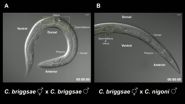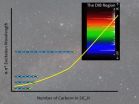(Press-News.org) A vaccine previously shown to reduce malaria in young infants and children reduces larger numbers of malaria cases in areas of higher malaria transmission, according to results from an ongoing clinical trial published in PLOS Medicine. The effect of vaccination diminished over time, but protection against clinical malaria remained evident 18 months after vaccination.
In the new report, the RTS,S Clinical Trials Partnership* update estimates of vaccine efficacy (the reduction in the risk of malaria in participants who received the vaccine compared to those who received a comparator vaccine) and calculate the number of cases of malaria that the vaccine prevented in a phase 3, randomized, controlled clinical trial of the malaria vaccine RTS,S/AS01 given to young infants and children in Africa.
The study included 6,537 infants aged 6–12 weeks and 8,923 children aged 5–17 months who were randomly assigned to receive three doses of RTS,S/AS01 or comparator vaccine. During 18 months following vaccination, the researchers report vaccine efficacy of 45% [95% confidence interval (CI): 41%–49%, intention-to-treat analysis] in children age 5-17 months, and 27% vaccine efficiency [95% CI: 21%–33%, intention-to-treat analysis] in infants age 6-12 weeks. In both age groups, vaccine efficacy was highest in the first 6 months after vaccination. Across all 11 study sites, RTS,S/AS01 averted an average of 829 (range 37 to 2365) cases of clinical malaria per 1,000 children vaccinated, and 449 (Range -10 to 1402) cases in infants vaccinated, over 18 months following vaccination.
Safety analyses found overall serious adverse events (SAE) to occur less often in children age 5-17 months who received the vaccine [18.6% (95% confidence interval 17.6%–19.6%), compared with 22.7% (95% CI 21.2%–24.3%) in children who received a comparator vaccine]. In infants age 6-12 weeks overall SAE were not found to differ significantly with immunization. As noted in earlier reports, more meningitis cases were reported as SAE in participants who received the malaria vaccine than in those who received a comparator immunization (16 cases among the 5,949 children in the RTS,S/AS01 vaccine group and one case among the 2,974 children in the control group; and nine cases among 4,358 young infants in the RTS,S/AS01 group and three among 2,179 young infants in the control group) and no causal relationship to the vaccine has been established.
Going forward the study will analyze further efficacy and safety results following administration of a booster immunization given to study participants just after the time period analyzed in the current report. The authors note that "Translated to the population at risk of malaria, reductions in clinical cases on this scale as a result of vaccination with RTS,S/AS01 would have a major public health impact."
INFORMATION:
Research Article
Funding: The study is sponsored by GSK Biologicals SA, the vaccine developer and manufacturer, and funded by both GSK Biologicals SA and the PATH Malaria Vaccine Initiative (MVI). The study was designed by the Clinical Trials Partnership Committee (CTPC), consisting of representatives of all research sites, study sponsor and study funders (as detailed in Leach et al. 2011). All authors were involved in data collection. All data were analyzed following a pre-defined analysis plan. The CTPC had full access to the study data, made the decision to publish the manuscript in its current form, and prepared the manuscript. The findings and conclusions in this article are those of the authors and do not necessarily represent the views of the Centers for Disease Control and Prevention (CDC).
Competing Interests: The trial was sponsored by GlaxoSmithKline Biologicals SA (GSK), the vaccine developer and manufacturer, and funded by both GSK Biologicals SA and the PATH Malaria Vaccine Initiative (MVI). All centers declare receiving a grant from MVI for running the trial. Author travel and accommodation related to this trial were financed by MVI. GlaxoSmithKline Biologicals SA received a grant from MVI to run the trial. MVI received a grant from the Bill & Melinda Gates Foundation to run this trial and to compensate MVI authors for trial-related travel. Additional conflicts of interest are as follows: JJA and PAl declare that their institutions received grant from the Catalan government and from the International Agency for Development and Cooperation. NA, CO, and KO declare that their institutions received a grant from the Malaria Clinical Trial Alliance. PB, SD, BG, CK, PL, CMai, GMwam, BO, and LO declare that their institution has received grants from MVI for other malaria studies. KM declares that his institution received a grant from the Wellcome Trust and that he received support from USAID and the Bill & Melinda Gates Foundation to participate in a scientific advisory group on malaria. MML declares that she received non-financial support from the WHO and the Biome´rieux Foundation. PN declares that she received financial support from GSK to present the results of the study at ASTMH congress in 2012. LO declares that he received support from GSK to carry out clinical and epidemiological studies. JSa has received (for the Center) some GlaxoSmithKline group of companies' consultancy fees for other studies. MTa is a board member of the Optimus Foundation, and his institution is reimbursed for his activities on the scientific advisory board of the Novartis Institute for Tropical Diseases. He also has received for his institution other grants from MVI and from the Bill & Melinda Gates Foundation, and travel reimbursements from MVI and Sanaria corp. All GSK Vaccines authors are, or were at the time of the study, employed by the GlaxoSmithKline group of companies. JC now works as an independent consultant for GSK Vaccines. WRB, JC, EJ, DLa, OOA, JV, AL, and MLi have shares/stock options in the GlaxoSmithKline group of companies. JC and WRB declare that they are named inventors on patents for which the rights have been assigned to GlaxoSmithKline group of companies. DK, DLe, and BS are employees at PATH-MVI. DSc is employed by the London School of Hygiene & Tropical Medicine, and his consultancy activities for MVI are funded as a grant to the LSHTM by MVI. DK holds stock or stock options from Merck, Sharpe & Dome.
Citation: The RTS,S Clinical Trials Partnership (2014) Efficacy and Safety of the RTS,S/AS01 Malaria Vaccine during 18 Months after Vaccination: A Phase 3 Randomized, Controlled Trial in Children and Young Infants at 11 African Sites. PLoS Med 11(7): e1001685. doi:10.1371/journal.pmed.1001685
Author Affiliations:
Albert Schweitzer Hospital, GABON
Institute of Tropical Medicine, University of Tübingen, GERMANY
Centro de Investigação em Saúde de Manhiça, MOZAMBIQUE
Universitat de Barcelona, SPAIN
Ifakara Health Institute, TANZANIA
Swiss Tropical and Public Health Institute, SWITZERLAND
Institut de Recherche en Science de la Santé, BURKINA FASO
Institute of Tropical Medicine, BELGIUM
KEMRI/CDC Research and Public Health Collaboration, KENYA
KEMRI-Walter Reed Project, KENYA
KEMRI-Wellcome Trust Research Program, KENYA
Kintampo Health Research Center, GHANA
London School of Hygiene and Tropical Medicine, UNITED KINGDOM
National Institute for Medical Research, TANZANIA
University of Copenhagen, DENMARK
School of Medical Sciences, GHANA
University of North Carolina Project, MALAWI
GlaxoSmithKline Vaccines, BELGIUM
PATH Malaria Vaccine Initiative, UNITED STATES
IN YOUR COVERAGE PLEASE USE THIS URL TO PROVIDE ACCESS TO THE FREELY AVAILABLE PAPER:
http://www.plosmedicine.org/article/info%3Adoi%2F10.1371%2Fjournal.pmed.1001685
Contact:
Mary J. Hamel
Division of Parasitic Diseases and Malaria
Centers for Disease Control and Prevention
UNITED STATES
+1 (404) 388-6811
mhamel@cdc.gov
*RTS,S Clinical Trial Partnership Committee members: Institut de Recherche en Science de la Santé (IRSS) / Centre Muraz, Nanoro, Burkina Faso; Albert Schweitzer Hospital, Medical Research Unit, Lambaréné, Gabon; School of Medical Sciences, Kwame Nkrumah University of Science and Technology, Agogo Presbyterian Hospital, Kumasi, Agogo; Kintampo Health Research Centre, Kintampo, Ghana; Kenya Medical Research Institute + Wellcome Trust, Kilifi, Kenya; Kenya Medical Research Institute + Walter Reed Army Institute of Research, Kombewa, Kenya; Kenya Medical Research Institute + US Centers for Disease Control and Prevention, Kisumu, Kenya; University of North Carolina Project, Lilongwe, Malawi; Centro de Investigação em Saúde de Manhiça, Manhica, Mozambique; Ifakara Health Institute, Bagamoyo, Tanzania; National Institute for Medical Research, Korogwe, Tanzania; GlaxoSmithKline (UK); PATH Malaria Vaccine Initiative (USA)
Malaria vaccine shows continued protection during 18 months of follow-up
2014-07-29
ELSE PRESS RELEASES FROM THIS DATE:
Small increases in Ugandan urbanicity tied to CVD risk factors
2014-07-29
Urban dwellers tend to have higher risk for cardiovascular diseases than people living in more rural locations. In a new study published in PLOS Medicine, Johanna Riha and colleagues, researchers from the University of Cambridge and the MRC/UVRI Research Unit in Uganda, have found that even within rural communities in Uganda that all lacked paved roads and running water, people living in villages with relatively more urban features—such as schools and health facilities –were more likely to have risk factors for cardiovascular diseases such as physical inactivity, lower ...
'Killer sperm' prevents mating between worm species
2014-07-29
VIDEO:
These are time-lapse videos of Caenorhabditis hermaphrodites that were (A) mated with the same species and (B) mated with a different species. Male sperm were fluorescently labeled and appear as...
Click here for more information.
The classic definition of a biological species is the ability to breed within its group, and the inability to breed outside it. For instance, breeding a horse and a donkey may result in a live mule offspring, but mules are nearly always sterile ...
Urbanization of rural Africa associated with increased risk of heart disease and diabetes
2014-07-29
The increasing urbanisation of rural areas in sub-Saharan Africa could lead to an explosion in incidences of heart disease and diabetes, according to a new study carried out in Uganda which found that even small changes towards more urban lifestyles was associated with increased risk of cardiovascular and metabolic diseases.
Over 530 million people live in rural areas of sub-Saharan Africa, where rates of cardiovascular and metabolic diseases tend to be much lower than in urban areas. However, many of these areas are becoming increasingly urbanised, with people living ...
Mysterious molecules in space
2014-07-29
WASHINGTON D.C., July 29, 2014 – Over the vast, empty reaches of interstellar space, countless small molecules tumble quietly though the cold vacuum. Forged in the fusion furnaces of ancient stars and ejected into space when those stars exploded, these lonely molecules account for a significant amount of all the carbon, hydrogen, silicon and other atoms in the universe. In fact, some 20 percent of all the carbon in the universe is thought to exist as some form of interstellar molecule.
Many astronomers hypothesize that these interstellar molecules are also responsible ...
This week from AGU: Cell tower rain gauges, lightning channels, North Sea storm surge
2014-07-29
This Week From AGU: Cell phone tower rain gauges, lightning channels, North Sea storm surge
From AGU's blogs: Dropped cell phone calls become rain gauges in West Africa
A shaky cell phone connection during a rainstorm can be an annoying nuisance. But now scientists are showing that these weakened signals can be used to monitor rainfall in West Africa, a technique that could help cities in the region better prepare for floods and combat weather-related diseases, according to a new study accepted for publication in Geophysical Research Letters, a journal of the American ...
Penn team makes cancer glow to improve surgical outcomes
2014-07-29
The best way to cure most cases of cancer is to surgically remove the tumor. The Achilles heel of this approach, however, is that the surgeon may fail to extract the entire tumor, leading to a local recurrence.
With a new technique, researchers at the University of Pennsylvania have established a new strategy to help surgeons see the entire tumor in the patient, increasing the likelihood of a positive outcome. This approach relies on an injectable dye that accumulates in cancerous tissues much more so than normal tissues. When the surgeon shines an infrared light on the ...
Huge waves measured for first time in Arctic Ocean
2014-07-29
As the climate warms and sea ice retreats, the North is changing. An ice-covered expanse now has a season of increasingly open water which is predicted to extend across the whole Arctic Ocean before the middle of this century. Storms thus have the potential to create Arctic swell – huge waves that could add a new and unpredictable element to the region.
A University of Washington researcher made the first study of waves in the middle of the Arctic Ocean, and detected house-sized waves during a September 2012 storm. The results were recently published in Geophysical Research ...
Underwater elephants
2014-07-29
In the high-tech world of science, researchers sometimes need to get back to basics. UC Santa Barbara's Douglas McCauley did just that to study the impacts of the bumphead parrotfish (Bolbometopon muricatum) on coral reef ecosystems at two remote locations in the central Pacific Ocean.
Using direct observation, animal tracking and computer simulation, McCauley, an assistant professor in the Department of Ecology, Evolution and Marine Biology, and his colleagues sought to understand whether the world's largest parrotfish is necessary for positively shaping the structure ...
Vision-correcting display makes reading glasses so yesterday
2014-07-29
BERKELEY — What if computer screens had glasses instead of the people staring at the monitors? That concept is not too far afield from technology being developed by computer and vision scientists at the University of California, Berkeley.
The researchers are developing computer algorithms to compensate for an individual's visual impairment, and creating vision-correcting displays that enable users to see text and images clearly without wearing eyeglasses or contact lenses. The technology could potentially help hundreds of millions of people who currently need corrective ...
Researchers take steps toward development of a vaccine against tick-transmitted disease
2014-07-29
Virginia Commonwealth University School of Medicine researchers have made an important advancement toward developing a vaccine against the debilitating and potentially deadly tick-transmitted disease, human granulocytic anaplasmosis (HGA).
During the past several years, experts have seen a steady rise in the incidence of human infections caused by tick-transmitted bacterial pathogens — making the need for a vaccine critical. Successful vaccine development hinges on knowing what to target to prevent disease, and the VCU team has identified three such proteins on the surface ...




